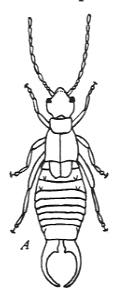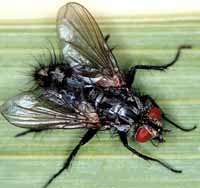
Earwigs
lay
their eggs in the fall. The mothers guard the eggs all winter, until
spring
warmth comes and the eggs hatch. At this point, the earwigs all
emerge--man,
woman, and child-- to FEED! The earwigs are ominvores, eating
aphids and
slugs (YES!) as well as marigolds, corn silks, and many other of
our
favorite vegetable leaves (NO!)! They are most active in our valley
during May, June, and July. Many people have said that this is the
worst
year for earwigs in Davis in a very long time.
An adult earwig looks like this:

Damage
looks like this (it may look differently, too... if there is severe
damage in
your garden right now, it is most likely earwigs. If you're not sure,
visit
your garden at night with a flashlight. You'll see them.

Another option is an oil trap. Use a fishy-smelling, unwashed, short tin can (tuna cans and catfood cans are ideal). Pour several centimeters of vegetable oil into the bottom. The earwigs will be attracted to the fishy smell, crawl in, and drown in the oil. Be sure to change the oil regularly.
The earwig's only insect predator in North America is the tachinid fly. It is attracted to alyssum, calendula, dill, and fennel. It looks like this:

Please
consider trying some sort of earwig control in your plot... your
plants
and your neighbors will appreciate it!